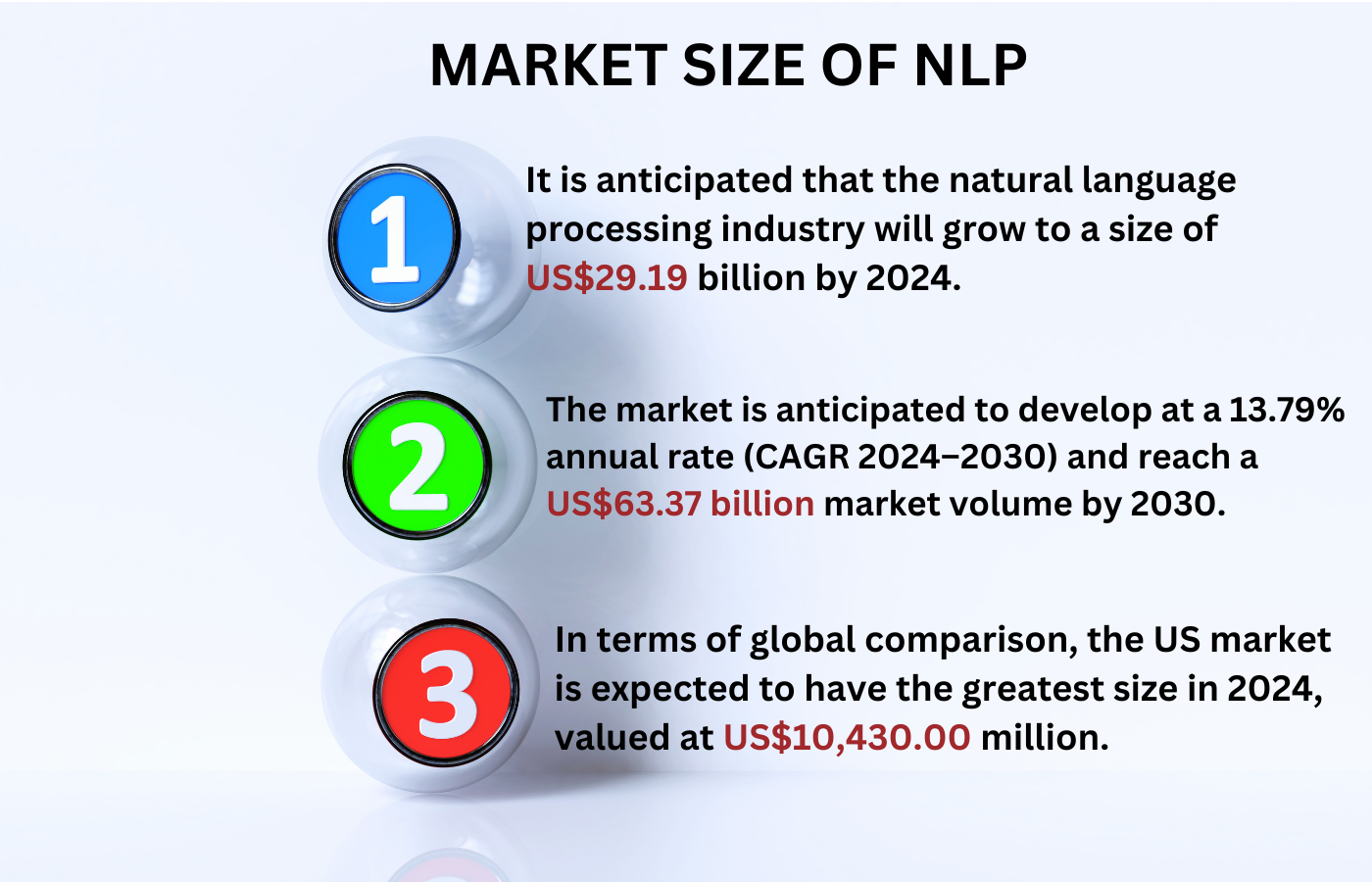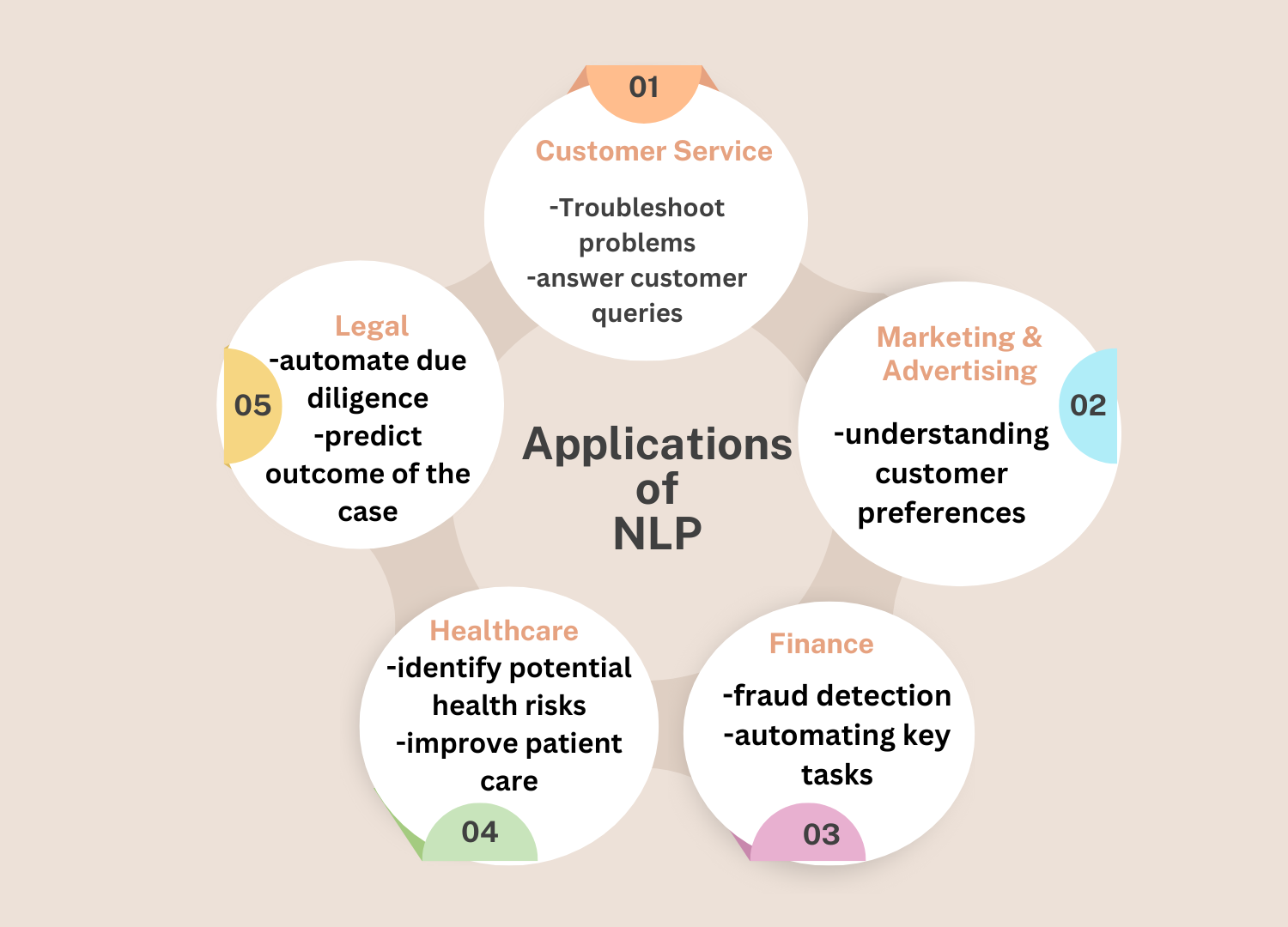Table of Contents
Natural Language Processing (NLP) is an exciting form of artificial intelligence that teaches machines to understand and use human language. Imagine the ability of a computer to read, write, and speak, just like us. NLP consultants are like having a brilliant assistant who can decipher the meaning and emotion behind our words. Now, let’s add some facts to make it more interesting: By 2025, the global Natural Language Processing tools market will be worth US$29.19bn, and experts predict it will grow extremely rapidly. In 2023, GPT-3’s big brother, a model called GPT-4, set a record by raising an incredible 1 billion words! Did you know that NLP has had amazing projects? Imagine you are dealing with a lot of text data, is it easy and time-consuming?
NLP can analyze thousands of pages in just a few seconds! NLP doesn’t just read; It is also good for composition. It can segment text, helping devices understand whether the message is happy, sad, or something else. Furthermore, it can teach a robot to recognize emotions! NLP libraries can easily process text sentences and convert them into structured objects. It’s like making your robot more organized and more efficient.
But here’s the surprising part – Natural Language Processing tools are critical to developing products we use every day. Have you ever asked Siri or Alexa a question?
That’s NLP at work! It also helps doctors understand patient data and triggers search engines to find exactly what you search for online. So, thanks to NLP and its libraries being available, those computers can read, understand, and talk like us! The main goal of NLP libraries is to make the text easier to handle. Furthermore, a high-level NLP library should accurately convert regular sentences into structured descriptions.
Introduction
Natural language processing services or NLP is a sub-field of artificial intelligence that studies human-computer interaction and tries to understand human language through NLP is commonly used in the development of applications such as word processors, search engines, banking apps, translation tools, and chatbots.
In data analytics, Natural Language Processing tools are used to enhance the narrative of data visualization, allow non-technical team members to interact with data, provide faster data discovery, manage analysis results, search for information that depends on language in many ways, resolve linguistic ambiguities, and helps to identify and mine texts.

What is Natural Language Processing & Its Significance in Businesses?
Natural Language Processing (NLP) is a technology that allows machines to understand, interpret, and produce human speech. Moreover, its main goal is to allow human machines to communicate in natural human language. To have a casual conversation, Natural Language Processing tools models need to be able to understand context, nuances of language, and even jokes and sarcasm. Furthermore, only large language models (LLMs) can perform these very complex tasks.
With so much information trained, they can understand the nuances of language and come up with answers that are not only technically sound but natural and human-like. But Natural Language Processing tools aren’t just about big language models. Many NLP applications don’t require such powerful tools. When an AI processes credit applications, its language skills don’t necessarily matter. All it has to do is learn how to analyze templates and forms and find the fields that contain the required data. Such models are much smaller, simpler, and require more computational power than LLMs.
Why does your company need NLP?
Your company needs Natural Language Processing tools first and foremost so that it can be processed based on data, and so that your employees don’t have to perform important but simple repetitive tasks to focus on tasks that greatly increase their importance. But what can artificial intelligence do for you specifically?
Listen to your customers
By analyzing tone and content, NLP enables a better understanding of customers by analyzing information posted on social media. One of the applications of NLP, sentiment analysis and social listening, helps top artificial intelligence companies to understand what customers think about their products or services. Sentinel, Brand24, or Hootsuite are the tools for this.
Don’t waste time exploring to access information in scanned documents:
While all company documents may soon be digital, many businesses still send paper documents and receive lost receipts. So the second area where Natural Language Processing tools can help is accessing information in company documents.
The key to machine understanding of what has been scanned is to distinguish between relevant data and irrelevant data. That is, finding, for example, the logo of the company that submitted the document or sensitive information from an accidental distortion.
The certified documents, or the information read from them, are then transferred to a digital database. In this way, it is very simple. What’s more, they can provide input for further operations, e.g. Posting expenses from a photographed receipt, noting the date of the event on the digital calendar of charity concert invitees, or sending a personal email receiving it to encourage feedback after the complaint process has been completed.
React quickly to threats and look for anomalies
Language analysis can identify disturbing patterns that could indicate potential fraud or attack. For example, a bank can monitor conversations to detect fraudulent attempts by customers, and your company can take note of unusual events.
There are other such examples:
- Remote business reports – if someone forgets to turn off the clock meter at night,
- social media analytics – when suddenly your company has an unusually high number of mentions or
- The analysis of report files (log files) – helps provide errors found in the operation of the software.
Benefit from the experience of others
The application of Natural Language Processing tools can also help improve knowledge management in an organization by simply producing meeting summaries and notes. Furthermore, this way, information is easily accessible to all team members.
Additionally, searching for company documents on the intranet, product knowledge, or searching for purchases and documents all related to a single customer can be surprisingly easy using NLP.
Automate natural language document processing
Natural language processing solutions make it possible to perform complex tasks such as document processing, saving time and increasing productivity. This is because document automation saves significant staff time and frees employees from complex and repetitive tasks that require greater accuracy.
Start by seamlessly copying data from paper forms to customer service functions. Furthermore, this can mean hours of glancing from the black-and-white desk to the monitor screen, or inserting a paper contract into the scanner and possibly only dealing with ambiguity and uniqueness.
However, automation in natural language processing is more than just processing documents. AI, using speech recognition, (STT), and speech and text processing, can create meeting summaries and notes, according to, among others: Otter, Rev, or Descript.
Achieve Un-paralled Accuracy and Efficiency with Our NLP Services
Use Cases of Natural Language Processing in Business
A bigger problem arises when companies have huge customer data that doesn’t provide any insights and information to manage the business.
Natural language processing applications and techniques help analyze irregular data to identify perceptions, behaviors, patterns, and other business-relevant insights What else can Natural Language Processing tools be used for? Let’s take a look.
Targeted advertising –
One day you search for a product on Amazon, and another day in a row Google advertises the same products for you. Have you wondered what happened here? Targeted Advertising! This is a form of online advertising where users are shown ads based on their online searches.
Most digital businesses use targeted advertising to save money and gain potential customers. The algorithm for targeted advertising is based on keyword matching. The NLP model captures such keywords and phrases to associate with advertising.
Other factors, such as recent website visits and frequency of website visits, influence targeted advertising programs. But the whole circle of keyword clocks is driven by Natural Language Processing tools.
Hiring and Recruitment –
With natural language processing, it is easy and simple and easy for recruiters to find the right candidates. Techniques such as named entity recognition and information extraction driven by Natural Language Processing tools are used to extract location, reputation, skills, and experience.
These factors can then be used to determine who is eligible and who is not. This unbiased resume filter and selection process reduced manual work by about 80%. Many companies also use Natural Language Processing software such as ATS (Applicant Tracking System) to better analyze resumes.
Social media monitoring-
Potential buyers of any business may be on social media to maintain a digital presence. Their daily feeds and posts provide huge amounts of data showing user’s buying patterns, customer behavior, likes, and dislikes.
Here, Natural Language Processing tools can help businesses analyze information posted on social media and extract relevant insights. Social media management also allows companies to analyze product issues that users encounter.
The use of chatbots –
Customer service and experience is the most important part of any business. We’ve already discussed the use of natural language processing in smart assistants and chatbots. However, as well as improving customer experience, Natural Language Processing tools also save on the administrative costs of hiring customer representatives.
From product recommendations to product information gathering, chatbots are the perfect partner for today’s consumers. Money, for example, is a chatbot app that offers financial planning solutions to millennials, thereby reducing costs and transforming traditional finance and wealth management.
Early assessment
The use of natural language processing is as broad as the one you use. Natural Language Processing tools also help businesses identify urgency in writing. Companies customize the NLP-based emergency recognition system and train it to recognize certain words and phrases that indicate dissatisfaction and gravity.
This allows businesses to prioritize the most important customer requests so they aren’t buried under piles of unresolved tickets. Required urgency also improves lead times, leading to greater customer satisfaction.
The powerful benefits of AI solution providers and Natural Language Processing tools are not limited to insights into the urgency of writing. In the current digital environment, every aspect of emergency management uses NLP-based applications and software in every industry.
It helps connect hospital patients with physical therapists in case of emergency treatment. A combination of natural language processing and artificial intelligence development is what every business needs to follow.
There are endless Natural Language Processing tools that can be adapted to the needs and strategies of any business. It would be advisable to seek professional expertise from a reliable machine learning consulting company for obtaining customized analytics and insights.
Summary of the text
The automatic text summary is pretty self-explanatory. The feature helps summarize the information by extracting functions and important keywords. The ultimate goal is to facilitate the process of transporting large amounts of data including legal documents, scientific papers, news reports/information, and more.
There are two standard NLP techniques that companies use to summarize data:
- Extraction-Based Summary – This is a summary of information without adding additional information by removing keywords and enlarging the text.
- Abstraction-Based Summary – This creates a new sentence that is identical to the original text. This approach is very common and works well in automating business processes.

The 10 most popular natural language processing tools for businesses
From machine translation, data collection, ticket classification, and spelling analysis, natural language processing (NLP) helps machines process and understand human language so they can perform common tasks on their own. Look at the top 10 NLP tools for companies to unlock the potential of AI.
1. Natural Language Toolkit (NLTK)
Natural Language Tools (NLTK) is the first Python platform for building programs to work with human language data. Linguists, engineers, and students consider it suitable because the community freely uses it as a tool.
NLTK also provides a guide to natural language processing through Python, which provides an introduction to language processing programming. As written by the creators of NLTK, it offers hands-on guidance through writing programs, classifying content, and exploring language structure, making the platform great for beginners
2. MonkeyLearn
MonkeyLearn is a machine learning platform for text analytics, which allows users to extract actionable data from text. Founded in 2014 and based in San Francisco, MonkeyLearn provides instant data visualization and advanced insights at a time when customers want to run analytics on their data. Customers can choose from ready-made machine learning models, or build and train them themselves. The company also has a blog dedicated to enterprise innovation, with how-to tips and tips for employees on how to expand their online presence and win searches.
3. Stanford CoreNLP
Stanford University Implementation builds and maintains CoreNLP, an NLP tool known for enabling users to derive linguistic annotations for text, including features such as token sentence boundaries, parts of speech, and numeric time values.
The program is written in Java, but users can interact by writing their code in JavaScript, Python, or another language. It also runs on Linux, macOS, and Windows, making it easy to use effectively.
4. spaCy
The Python-based library provides language support at efficient speeds for over 72 languages in spaCy transformer-based pipelines. The final version provides new training programs and templates for projects that allow users to define their reporting models.
They also offer free interactive tutorials for users who want to learn how to use spaCy to develop natural language understanding systems. It uses rule-based machine learning, making it easier to comply with.
5. MindMeld
MindMeld, Cisco’s proprietary conversational AI platform, delivers functionality at every step of the modern conversational workflow. This includes knowledge building to conversation management. Blueprints are readily available for conversational use, such as food ordering, video discovery, and home assistant for devices. Cisco has a regular blog where its NLP experts talk about the platform with a wide variety of topics including programming, app development, and hands-on experience with automation
6. Amazon Comprehend
Amazon Comprehend is also a service that uses machine learning to uncover valuable insights and connections in text. The program can be used in examples such as recording and analyzing inventories, managing legal briefs, and preparing financial documents.
7. Microsoft Azure
Microsoft Azure Cognitive Service for Language provides conversational language understanding to enable users to create objects for use in end-to-end chat services Through the service, users can have a chatbot, a person assistant bot to support customer engagement, as well as mandatory control applications It can have a clear policy for business use and clear standards for how AI should be used.
8. OpenAI
The release of the open AI chatGPT3 large language model in 2020 is a milestone in NLP. Its successor, GPT-4, a larger multi-depth learning platform that can accept images and input data and provide input, builds on these innovations.
OpenAI states that GPT-4 is a great multifold model that, although less capable than humans in many real-world scenarios, reflects the human level of performance and learning concepts to use it for. Natural Language Processing projects such as text classification, sentiment analysis, language translation, text generation, and queries can be done.
9. IBM Watson
Named after technologist Thomas J. Watson, IBM’s founder and first CEO, IBM Watson helps top machine learning companies predict future results and automate and professionalize complex processes time is good.
Watson was developed as a Question and Answer (QA) computing system built by IBM to use advanced Natural Language Processing tools, information retrieval, knowledge representation, automated reasoning, and machine learning in the field of open-ended questions.
Today, Watson’s cloud-native natural language understanding uses deep learning models to extract semantics and metadata from unstructured textual data, enabling users to extract categories, categories, objects, keywords, emotions, emotions, relationships, and syntax from text.
10. Google Cloud
Thanks to clients like DocuSign and Ocado, Google Cloud’s NLP platform allows users to extract insights from unstructured data using Google machine learning.
Google Cloud AutoML enables users to train their high-quality machine-learning custom models to classify, extract, and detect emotions with minimal effort and machine-learning expertise, using Vertex AI for natural language, powered by AutoML.
You can use the AutoML UI to test the prototype. Meanwhile, Google Cloud Natural Language API allows users to filter content, analyze sentiment and syntax, and categorize text.
Developers can use natural language understanding (NLU) in their applications through features such as sentiment analysis, entity analysis, entity emotion analysis, content classification, and syntax analysis.
Our Experts Get Everything Covered For you From Sentiment Analysis to Language Translation
A3Logics: Your NLP Powerhouse – Unlocking Insights from Your Text Data
Struggling to extract valuable insights from your ever-growing mountain of text data? Look no further than A3Logics, a top artificial intelligence solutions company. Your one-stop shop for all things natural language processing (NLP).
A3Logics goes beyond just providing Natural Language Processing tools. They work with you to understand your specific needs and challenges, using their expertise to create custom NLP solutions that deliver real business results. Here’s how to power your NLP journey:
The foundation of any successful NLP project is clean and high-quality data. A3Logics meets this challenge head-on. Provided by:
Web Scraping:
Extract valuable data from websites and online sources related to your project.
Data Cleaning and Preprocessing: Convert raw data into a format suitable for NLP analysis, ensuring accuracy and efficiency.
Optimized NLP Solutions:
A3Logics does not believe in a one-size-fits-all approach. They offer a wide range of Natural Language Processing applications, e.g. Text analysis and summary.
Extract key points and compile larger points into concise summaries for better understanding.
Emotional Analysis:
Uncover the hidden emotions and moods in your text data to measure customer satisfaction, brand sentiment, or market trends
Entity Identification and Classification: Identify and classify entities (people, organizations, places) in your text, and provide valuable insight into your data.
Machine translation:
Break down language barriers and open up global markets. A3Logics offers accurate and meticulous translations tailored to your specific needs.
Customized NLP enhancements: For unique challenges A3Logics can create custom NLP models trained on your specific data, ensuring the most relevant and insightful results.
Skills & Experience:
A3Logics boasts a team of experienced NLP professionals with a deep understanding of the latest developments and best practices. You will be guided through each step of the process, ensuring that you fully utilize the power of NLP.
Focus on definition and clarity:
A3Logics understands the importance of trust. NLP models are developed that are not only realistic but also interpretable, allowing the reasoning behind the results to be understood. This transparency gives you confidence in your data-driven decisions.
Scalability and cost:
Whether you are a start-up or a larger business, A3Logics has a solution for you. They offer customizable services to fit your needs and budget, giving you a great return on investment (ROI).
The partnership with A3Logics means harnessing the power of NLP to
- Go deeper into your customer insights
- Improve decision-making processes
- Create quality content marketing strategies
- Increase productivity
- And so much more!
Don’t let your text data sit unused! Contact A3Logics today to unlock the full potential of NLP for your business.
Final Thoughts
The breadth of NLP tools can be overwhelming. But don’t be afraid! By understanding your specific needs and considering the above-mentioned factors, you can determine the perfect tool to further enhance your text analysis.
Here is a quick recap:
- Focus on your goals: What insights do you want to gain from your text data?
- Consider user-friendliness: Is ease of use important, or are you comfortable learning deeply for advanced features?
- Check pricing and flexibility: Choose a tool that fits your budget and suits your growing needs.
- Look for free trials and demonstrations: Use a trial period to try out different tools and see which ones are right for your business.
Don’t be afraid to experiment and explore! The right NLP tool can be a game changer, turning your textual data into actionable business intelligence.
Harness the potential of natural language processing for your business success
FAQs
1. What are typical NLP tasks?
Text analysis, sentiment analysis, entity recognition, and machine translation are all popular applications of NLP.
2. Which companies benefit the most from NLP?
Customer service, marketing, healthcare, finance, and social media analytics are a few examples.
3. Do I need coding experience to use NLP tools?
Many NLP tools provide user-friendly interfaces, but some require programming skills to perform advanced functionality.
4. How much does NLP software cost?
Pricing varies depending on the equipment’s features, customizability, and your specific needs. There are open-source options, which include paid plans with different levels.
5. What are some security considerations when using NLP tools?
Make sure the tool you choose has strong security measures to protect your sensitive data.
6. How can I stay updated on the latest NLP developments?
Follow industry publications, attend conferences, and explore the resources of leading NLP companies and research institutes.
7. Is it better to use a pre-built NLP tool or create a custom prototype?
Pre-built tools offer fast and cost-effective solutions for common NLP tasks. Custom models may need to be developed for very different requirements or unique data sets.






